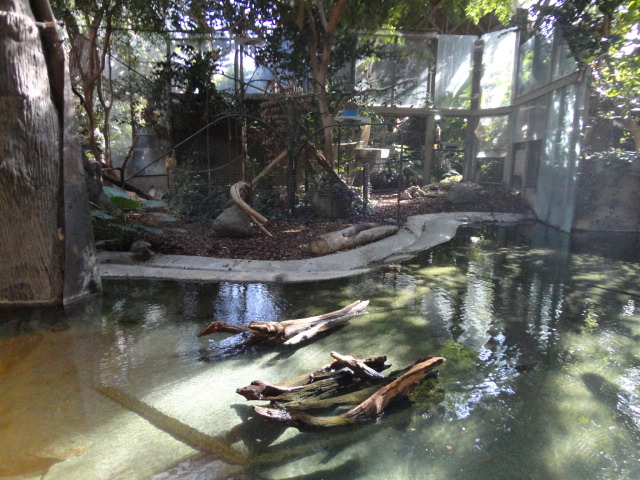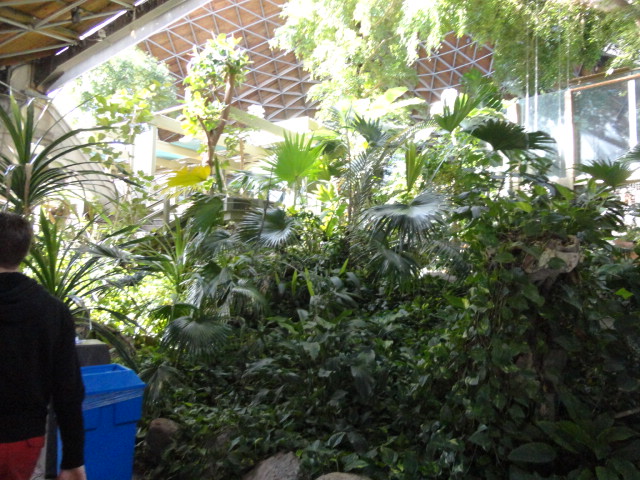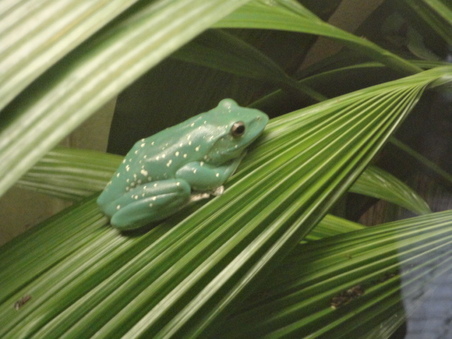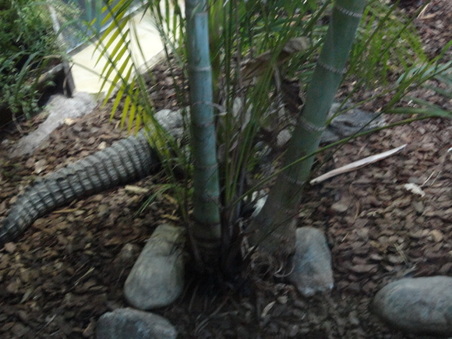Reflections of the Natural Ecosystem
How does the display accurately reflect the natural ecosystem of the organisms?
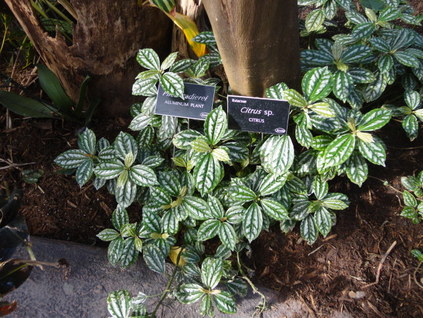
When entering the tropical forest area, which includes the Malaya, African rainforest pavilion and the Americas, all of them display the natural ecosystem in terms of the climate fairly well. As we enter, we can feel the sudden change of humidity and temperate. As the zoo aimed to reflect the climate by making the temperature higher and increasing the humidity. As for the landscape, the pathways were also wet, although I am not sure if the zoo intended to do this or did it to reflect the actual ecosystem. The plants in the landscape were also real and from tropical rainforests. All animals that were displayed in the zoo fit their habitat. For example, for the chameleon in the african rainforest, the trees, soils and branches fit to where their actual habitat is. Orangutans, who were in the Malaya section, would also get large trees as they are animals that live on canopies. The unrealistic part for orangutan and also the gorilla habitats was that, they would have playgrounds where the animals would play at. Artificial objects like tires and ropes would exist for them to climb on. One of the most realistic part of the rainforests were the noisy sounds. As rainforests contain many organisms that call out, the zoo had many of them. At times all I could hear were the sounds of the creatures and they accurately reflected the ecosystem. One of the ways how the zoo did not reflect the actual ecosystem was because the animals in the rainforests did not coexist with each other. In the natural ecosystem, animals would not be separated from each other and the struggle for existence would be real.
Animals
Chameleons (Additional info)
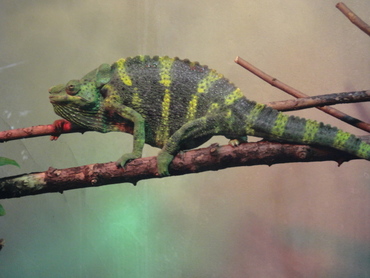
Chameleons are mainly tropical rainforest animals and live around trees. They are carnivorous reptiles as they feed on insects. We can see how Chameleons reflect the tropical ecosystem. Since, rainforests contain abundant amount of trees, the chameleon effectively adapts its surrounding by using trees as their homes. They also live on trees because they need the sun to keep them warm. Staying above the normal height will give them a greater portion of the sunlight. Chameleons therefore adapted so that it can live in the rainforest habitat.
The most known of the chameleon, is its ability to change colour. Chameleons changes its colour depending on its situation. But all of its changes colour have to do with the rainforests ecosystem. One of its uses is to camouflage around its surroundings to hide from predators. For chameleons, camouflaging is more effective because they are slow moving creatures. By lowering its speed, chameleons had to find a new way to protect itself from predators, which was camouflaging. Chameleons also change colour so it can absorb more sunlight. They do this because they want to regulate their body temperature. By changing to darker colours they can absorb more sunlight compared to a lighter colour.
Since the rainforest are warm and humid, chameleons are well suited for this environment as they are reptiles. They are well suited to live in warm climates because Cold-blooded animals cannot generate their own heat. That is why we can see how Chameleons reflect the warm and damp ecosystem of the rainforest.
Chameleons also adapted to the rainforest ecosystem by having extremely long tongues. Since, chameleons live on trees, when hunting for insects it is very difficult to obtain the pray. That is why chameleons have tongues that can extend one and a half times their body. By having long tongues they can use less energy to obtain the prey. With long tongues, chameleons also do not need to leave the security of the trees when they need to drink water. Chameleons can use their tongue to obtain enough water just by licking waters off of leaves and rain.
With all of chameleons adaptations to the rainforest, we can see how the the warm climate and abundant trees can create an affective ecosystem for the chameleon. It's long tongue is useful so it can reach far distant trees to drink water and to hunt preys. Living on trees will let them to live safely from the dangers below.
The most known of the chameleon, is its ability to change colour. Chameleons changes its colour depending on its situation. But all of its changes colour have to do with the rainforests ecosystem. One of its uses is to camouflage around its surroundings to hide from predators. For chameleons, camouflaging is more effective because they are slow moving creatures. By lowering its speed, chameleons had to find a new way to protect itself from predators, which was camouflaging. Chameleons also change colour so it can absorb more sunlight. They do this because they want to regulate their body temperature. By changing to darker colours they can absorb more sunlight compared to a lighter colour.
Since the rainforest are warm and humid, chameleons are well suited for this environment as they are reptiles. They are well suited to live in warm climates because Cold-blooded animals cannot generate their own heat. That is why we can see how Chameleons reflect the warm and damp ecosystem of the rainforest.
Chameleons also adapted to the rainforest ecosystem by having extremely long tongues. Since, chameleons live on trees, when hunting for insects it is very difficult to obtain the pray. That is why chameleons have tongues that can extend one and a half times their body. By having long tongues they can use less energy to obtain the prey. With long tongues, chameleons also do not need to leave the security of the trees when they need to drink water. Chameleons can use their tongue to obtain enough water just by licking waters off of leaves and rain.
With all of chameleons adaptations to the rainforest, we can see how the the warm climate and abundant trees can create an affective ecosystem for the chameleon. It's long tongue is useful so it can reach far distant trees to drink water and to hunt preys. Living on trees will let them to live safely from the dangers below.
Orangutans (Additional info)
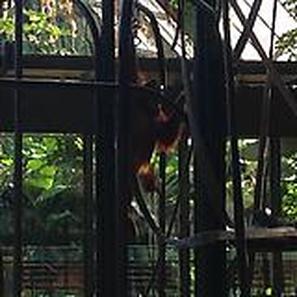
Orangutans are in the order of primates and they live in tropical forests around Indonesia and Malaysia. Just like chameleons, orangutans live on tree canopies for most of their days. Orangutans are actually the last of the great apes to predominantly travel through trees.They have adapted to live on the rainforest trees. We can see this because they have an arm length of 7 feet.
We can see that orangutans reflect the natural ecosystem of rainforest as we contrast other primates. Chimpanzees, gorillas live terrestrially (living on ground). Orangutans being one of the few great apes to actually travel on trees, we can see the effect of how its ecosystem effects the organanism.
We can see that orangutans reflect the natural ecosystem of rainforest as we contrast other primates. Chimpanzees, gorillas live terrestrially (living on ground). Orangutans being one of the few great apes to actually travel on trees, we can see the effect of how its ecosystem effects the organanism.
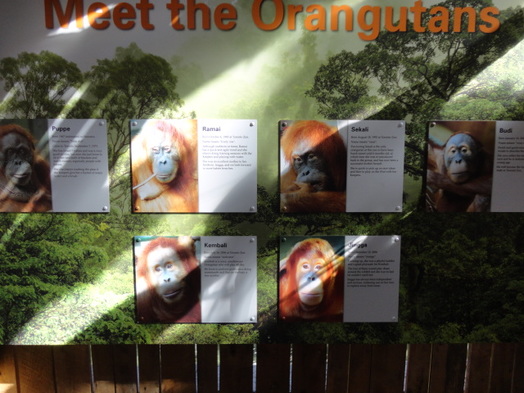
50% of orangutan diets are fruits and other foods such as seeds, flowers, shoots, nuts, ants are eaten. We can see the relationship between orangutans and the plants. When a orangutan eats fruits, nuts, or seeds, their seeds will be planted by orangutan's feces. Orangutans help the plants and the plants help the orangutans.
Orangutans are also well camoflauged in rainforests as their orange coloured hairs. The sunlight that passes through the dense trees reflect green light, while absorbing red light. Because of the absorption of red light, orangutans are harder to spot in the rainforest.
Orangutans are also well camoflauged in rainforests as their orange coloured hairs. The sunlight that passes through the dense trees reflect green light, while absorbing red light. Because of the absorption of red light, orangutans are harder to spot in the rainforest.
